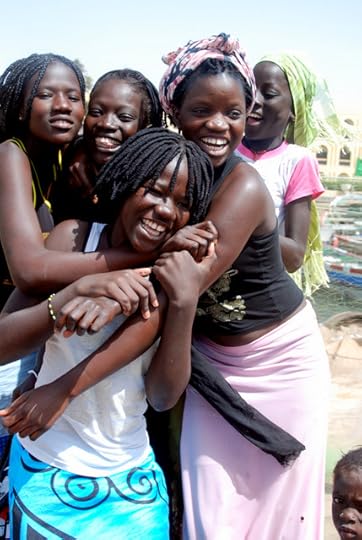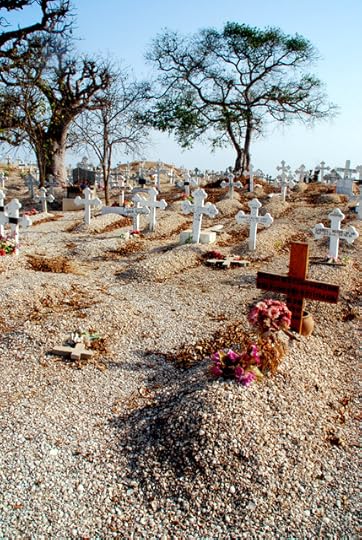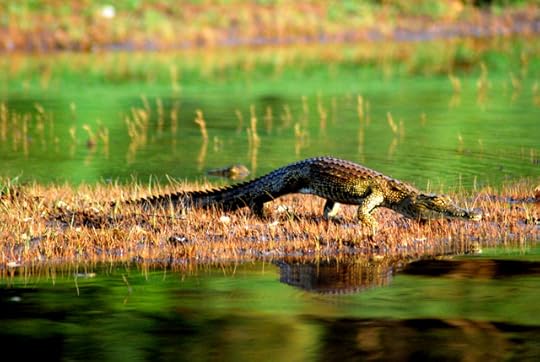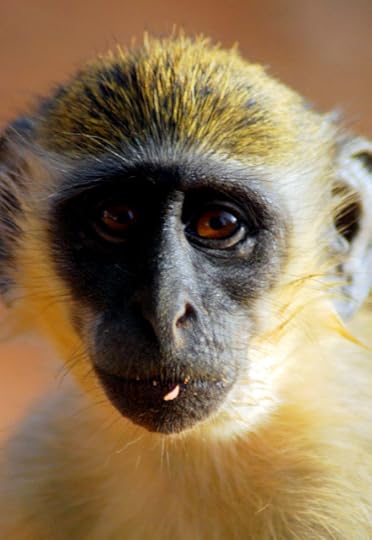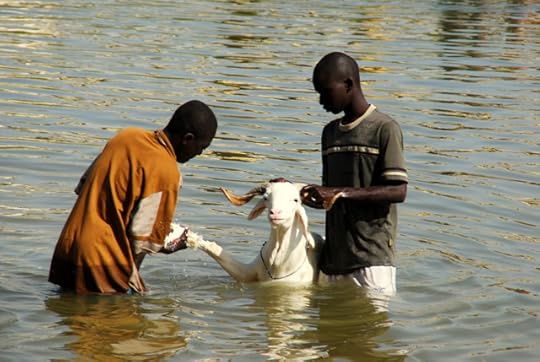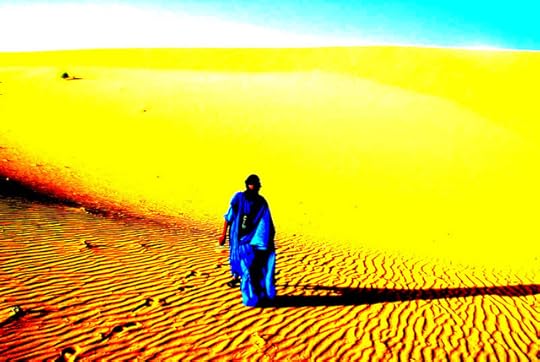Roderick Phillips's Blog, page 15
March 5, 2014
Guet NDar and Saint Louis, Senegal, Day 220
Today we explore Saint Louis and it’s near neighbor Guet NDar. We had planned to visit Saint Louis upon completion of our Dragoman trip and as Christi and I made our way north to Mauritanian border, but Adonis is pulling out all the stops to ensure the group sees as much of Senegal as possible in the last few days aboard the truck. And the truth is that it would have been impossible to cover as much of West Africa in the same time period as an independent traveler, so while Christi and I have had to make some compromises and there have been some personnel issues, by and large the trip has been a resounding success. Not, I hasten to add, to the extent that Christi and I will sign up for another Dragoman adventure any time soon, because basically we prefer independent travel.
Saint Louis is split between the mainland ( the modern, less interesting part) and an island in the middle of the Senegal River that is home to the Old Town. The island is joined to the mainland via the 500m-long Faidherbe bridge. Directly across from the bridge is the Hotel de la Poste where French aviators stayed en route to South America to deliver the mail (a distance of 4,800 miles in precariously small planes). Saint Louis is actually the oldest French settlement in West Africa and was the capital of the French colony of Senegal from 1673 until 1902 when the capital was moved to Dakar. Interestingly, from 1920 to 1957 Saint Louis also served as the capital of the neighboring French colony of Mauritania.
I must admit to being a little disappointed with Saint Louis. Despite its UNESCO world heritage status, Saint Louis is just another colonial city crumbling into history. There are the usual cafes and shops catering to tourists, but at least the ambience is more mellow than the chaos and madness of Accra and Bamako. Before Christi and I can begin to explore, though, I have to go grocery shopping yet again ahead of my final cooking rotation tomorrow night. My cooking partner this time is the diminutive Louise (of Thelma and Louise fame). One thing’s for sure, by the end of this trip I’ll definitively know how much food to buy to feed 20 people. With that final chore complete (aside that is from the daily torture of loading and unloading the damn bags from the truck) Christi and I wander the sandy, litter-strewn streets of Saint Louis, but there is not much grandeur left. The charm and mystique is as faded as the dull pastel colors of the buildings. The Hotel de la Poste is surprisingly unsympathetic to people who only want a quick snoop and have no intention of staying for lunch. We did, however, receive a personal guided tour off the premises!
The day perks up considerably when we cross a second bridge that connects Old Town Saint Louis to the upper part of the Langue de Barbarie peninsula. Directly opposite Old Town on the peninsula is the charasmatic fishing village of Guet NDar. Indeed, the channel between St. Louis and the peninsula is chock full of fishing boats, while the village, itself is much more vibrant, frantic, and authentic. What you see is what you get, which is ordinary Senegalese folks going about their daily lives. There are no requests for cadeau nor much interest in us at all to be frank. Still it’s fascinating to experience this authentic way of life. At one point I’m surrounded by a group of teenage girls who spontaneously start to pose for the camera. For just a moment a connection exists between us, a shared experience, that is so much more rewarding than staring at the crumbling architecture of Saint Louis.
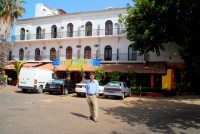
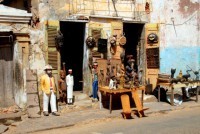
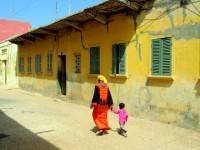
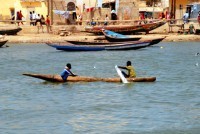
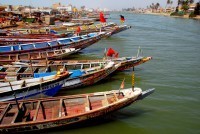
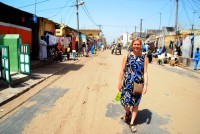

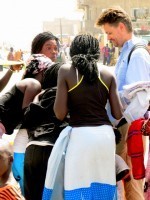
Blog post by Roderick Phillips, author of Weary Heart – a gut-wrenching tale of broken hearts and broken test tubes.
The post Guet NDar and Saint Louis, Senegal, Day 220 appeared first on Roderick Phillips.
March 4, 2014
Joal-Fadiout, Senegal, Day 219
Today is a big day for me because I finally begin my cook group activities aboard the Dragoman truck. And let me be quite clear that I have never cooked for 20 people before and I have no idea how to cook for 20 people. Also I’m feeling a little pressure because all the meals that have been cooked on the truck so far have been tasty and plentiful. My cooking partner is John Malkovich. Our main tourist activity today is a visit to the twin villages of Joal-Fadiout, which lies further up the coast from Palmarin. The drive this morning is quite wonderful across the deserted salt flats, marshes, and lagoons that form part of the Sine-Saloum Delta. There’s plenty of crabs, wading birds, and even a few jackals returning from their nocturnal hunts to enthrall us.
Joal-Fadiout are two towns joined by a 500m long wooden bridge, deluged with bird droppings. Fadiout is a small island on the Atlantic seaboard made completely of oyster and clam shells. A second shell island to the northwest is connected to Fadiout by yet another wooden bridge. this second smaller island is both a Muslim and a Christian cemetery – even the graves are made of shells. There are also several baobab trees in the cemetery, all crying out to be photographed. Fadiout is clearly used to tourists, though, judging by the ubiquitous handicrafts, not to mention the irate market stall-holders demanding a ‘cadeau’ every time I raise my camera. Our tour group is given very little time to explore, which is a shame because it is a unique place. Certainly more appealing than it’s near neighbor Joal, which is located on a narrow spit of land connected to the mainland. Fortunately, John Malkovich and I are pre-occupied with scavenging for food. It’s like some bizarre reality TV show. We are given CFA 50,000 (US$100) and 30 minutes to shop. As usual there is no convenient grocery store so John and I are running around a rubbish-strewn daily market, trying in real-time to come up with a plan for breakfast, lunch, and dinner based on the quality and abundance of the fresh produce we encounter. Christi helps out and we stagger back to the truck weighed down with apples, bananas, oranges, green beans, green bell peppers, potatoes, onions, tomatoes (tinned and fresh) and carrots. We have the ingredients, now all we need is culinary inspiration.
We have plenty of time to ponder our dish because the rest of the day is taken up with a long coastal drive north to Saint Louis, which lies only a stone’s throw from the border with Mauritania. Our campsite for the next few nights is the Zebrabar on peninsula Langue de Barbarie, some 20 km south of Saint Louis, but right beside the ocean. While Christi puts up our tent, John Malkovich and I set to work preparing dinner, ably assisted by Thelma and Louise, Sinead O’Connor, and latterly Christi. Either I’ve suddenly become very popular or the rest of the group really fears for their dinner.
Margaret Thatcher is having one of her routine moans. She’s decided she doesn’t like curries, which is a shame because John and I had decided on a vegetable curry. (Note we ate a lot of vegetarian food on this Dragoman trip because the meat at the various markets always looked a bit suspect – particularly after the flies had finished defecating and laying their eggs on it (caviar it ain’t!)). Poor Dennis is routinely dispatched from the Thatcher tent to check on our progress. Dennis appeals to John Malkovich’s better nature, citing how much easy his life will be if we made a vegetable casserole instead. Sadly, John does not have a compassionate side so Dennis tries to swipe the curry powder. This does not go down too well with Mr. Malkovich who brandishes a rather large carving knife in Dennis’ bemused face. Tempers flare; there’s pushing and shoving. The rest of the group form a circle around the combatants and chant ‘fight, fight’ at which point Adonis appears (with a newly ruffled Aphrodite in tow) to prevent fisticuffs. Disappointed, the group disperses to the bar in search of hard liquor, leaving John and I to create a culinary masterpiece. Well no one complained about the dinner anyway (and the fact that John continued to wield the carving knife quite malevolently throughout the dinner had no influence on people’s opinion whatsoever).
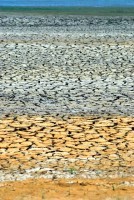
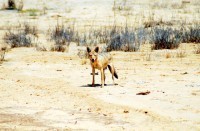

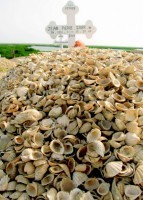
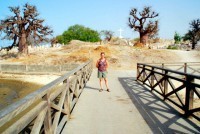
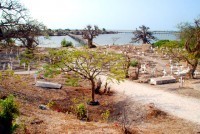
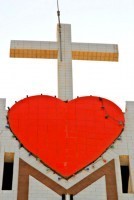
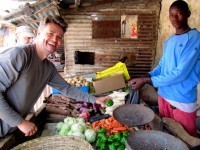
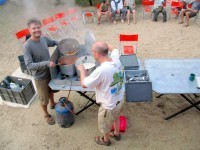
Blog post by Roderick Phillips, author of Weary Heart - a gut-wrenching tale of broken hearts and broken test tubes.
The post Joal-Fadiout, Senegal, Day 219 appeared first on Roderick Phillips.
March 3, 2014
Sine-Saloum Delta, Senegal, Day 218
Today is an all day pirogue trip through the Sine-Saloum Delta, which is full of mangrove swamps, palm groves, shimmering flat lands, salt marshes and lagoons. We take two pirogues, which are not that big or that comfortable. Unexpectedly we set out across open water, which is a little rough, especially for Margaret Thatcher who begins to feel quite unwell. Our first activity is a quick safari through mangrove creeks, looking for the West African manatee, but our guide, Pap, shoots that idea down immediately, insisting that the animals have been hunted to virtual extinction in this area. As we potter along the mangrove creeks, the scenery reminds me of the Galapagos Islands.
As predicted we see little wildlife and continue on to our next stop in the Sine-Saloum Delta, the shell village of Falia. The locals are a very friendly bunch and are actively shucking oysters and clams when we arrive. They even use the discarded shells to build up the height of the island, because even in this remote part of the world the effects of global warming are a real concern. During a typical day the villagers go looking for shell-fish at low tide, while at high tide they fish for lotte au curry (monkfish). Rather embarrassingly a very attractive teenage girl called Isadoo decides to befriend me and shyly takes my hand in hers. With our hands entwined we explore this island while the rest of the group snigger, but Christi is completely unconcerned. I do manage to untangle myself briefly when called upon to participate in the local shell dance with another woman from the village. As usual in such situations, Christi fades into the background avoiding the embarrassment of boogying on down in public. Isadoo seems genuinely disappointed when the tour group leaves Falia without her; perhaps she was expecting to go with me. For all I know holding hands around here means I married the girl.
Again the waters of the Sine-Saloum Delta are a little choppy as we cross more open water and head for a tiny deserted island with golden sand and thick stands of mangrove. This is our lunch stop. And while Pap barbeques lotte au curry for us to eat, Christi and I explore the area. There is an abundance of small immature fish that use the mangroves for protection and food, while crabs clamber along the boughs of the mangrove trees, and huge jellyfish bob about in the shallows. The jellyfish are a good foot in diameter and come with 12’’ long red tentacles. They look extraterrestrial.
We hang out on this spit of sand and mangrove swamp for most of the afternoon before returning to Palmarin. On the way back I get thoroughly drenched as the pirogue bounces across the delta, splashing water into the boat. This together with the drop in temperature leaves me feeling wretched and by the end of the day I’m coughing and sneezing. Who catches a cold in Africa for goodness sake!

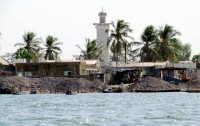
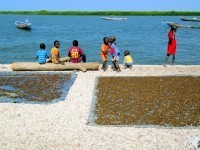
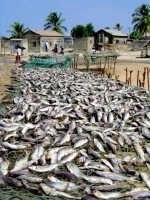
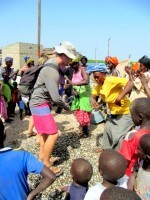
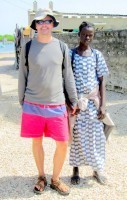
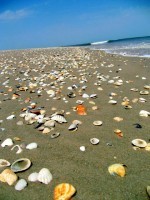
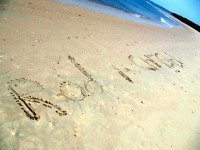

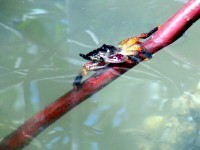
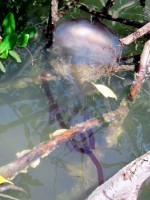
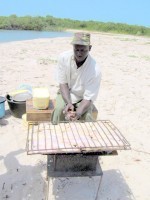
Blog post by Roderick Phillips, author of Weary Heart – a gut-wrenching tale of broken hearts and broken test tubes.
The post Sine-Saloum Delta, Senegal, Day 218 appeared first on Roderick Phillips.
March 2, 2014
Tambacounda and Palmarin Day 217
Sadly, Dragoman allocates only one full day in Parc National du Niokolo-Koba and it’s time to move on via Tambacounda to the coast. When Timbuktu was removed from the official Dragoman itinerary, something had to be substituted to fill in the time. The choice was made to visit the coastal village of Palmarin, which is the gateway to the Sine-Saloum Delta in southern Senegal. Dragoman alloted three driving days and two nights of bush camping (billed as a highlight remember!) to reach this coastal community. Quite why we couldn’t spend extra time on safari, I don’t know. There’s got to be wildlife in this park somewhere. Adonis is a good tour leader, though, realizing that the group had already got about as much enjoyment as it was likely to get from bush camping (or perhaps Aphrodite was finding it hard to maintain that English Rose glow in the absence of a daily shower). Either way, Adonis came up with a plan B last night, adding the northern Senegalese colonial town of Saint Louis to our agenda. In order to accommodate both Palmarin and Saint Louis, though, we have to reach Palmarin today. It will be one very, very long driving day (instead of 3 shorter days of driving and 2 nights of bush camping). In order to change the itinerary Adonis needs all the group to agree. Margaret Thatcher is about to open her mouth when a rare but well-aimed elbow in the ribs by Dennis stymies any possible protest.
Consequently the day begins in the middle of the night. Poor Christi and Hu-man start preparing breakfast well before sparrow fart, while I’m left to pack up our room. This isn’t easy because there is currently no power and no water. Christi and Hu-man once again have to go shopping in Tambacounda for lunch provisions. There was little of interest to explore last time we were here, so most people remain on the truck or volunteer to help Christi, Hu-man, and I to go shopping. I do spot one miracle or mirage in Tambacounda this morning, which I have never seen before or since: a trash collector. It’s a one-man operation with a donkey and cart. Needless to say, this man will never be out of a job, although quite why he does this is beyond me. It’s his poor donkey I feel sorry for as it strains under the deluge of garbage.
With lunch secured, it’s back on the truck. Christi injects me with some butt-numbing concoction from her portable pharmacy and I settle back to the longest Dragoman drive of my life. We stop briefly for lunch and for the last time on this trip Christi and Hu-man feed 20 ravenous faces. Apparently doing nothing is hungry work. The disappointing from my perspective is that I have yet to even begin this onerous chore. The closer we get to the coast, the better the roads become, but then there is more traffic, more police check points, more wandering cows, and more people who all think they have the right of way – even though we are in a 5-ton truck. The best part of reaching Palmarin and the Auberge Djidjack is the sudden drop in temperatures, although ironically, when the sun sets, I’m frantically searching for a sweater despite the fact it’s 75oF.
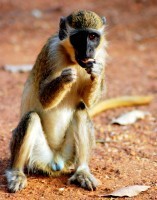
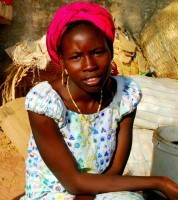
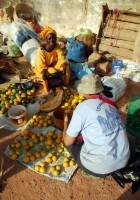
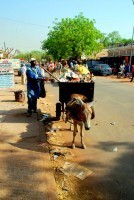
Blog post by Roderick Phillips, author of Weary Heart, a gut-wrenching tale of broken hearts and broken test tubes.
The post Tambacounda and Palmarin Day 217 appeared first on Roderick Phillips.
March 1, 2014
Gambia River, Senegal, Day 216
Twenty people in a pirogue are not the ideal conditions for a safari along the Gambia River in search of hippos and crocodiles, but that’s the Dragoman way. Even before that, though, there’s a very nice sunrise over the river. The cost to the kitty is US$10 for the 90-minute boat ride and the services of a guide. In fact you have to pay for the guide whether you want one or not, although to be honest I’m pretty good ay distinguishing a crocodile and a hippo for myself.
Over the 90 minutes the Gambia River reveals little of its true secrets, although we do spot some hippos and a Nile crocodile, but no elephants or lions or leopards. If any of them remain in the park they are keeping a low profile today. There’s another warthog (or maybe its the same one from yesterday), a lone Nyala antelope, and a smattering of exotic birds (which Christi enjoys), but the safari generally offers slim pickings. Probably the best part of zooming up and down the Gambia River is the breeze, which relieves some of the ongoing oppressive heat.
Later Christi and I sit by the pool with Adonis and Sheldon Cooper who is the only other member of the group to actually commit to continuing overland into Mauritania with us and the enigmatic fixer, Ahmed the Finger. Adonis gives us some tips on the route Dragoman would have followed and what we might expect from Ahmed. Having Sheldon Cooper on board makes the trip cheaper and he can speak French. In theory this all to our advantage. In theory.
While Christi and Hu-man set about the chore of making dinner, I wander off to the watering hole in search of solitude and wildlife. Again, though, wildlife spotting is at a premium, which is made all the more difficult by the appearance of a noisy group of French tourists who don’t appear to grasp the fact that silence is advantageous when looking for wildlife. I leave in a huff.
Despite Christi’s concerns, dinner once again proves to be a delight (it’s potato curry), although she and Hu-man cook enough rice to feed 50 people let alone 20. Quickly clear up after dinner so Christi and I can get the full benefit of the air-conditioning in our room. We fall asleep in blissful comfort.

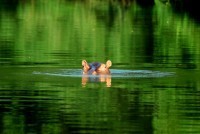
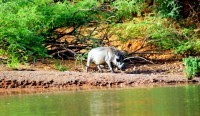
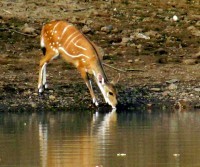
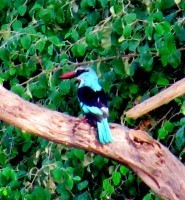
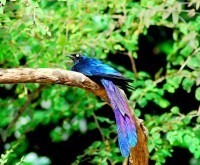
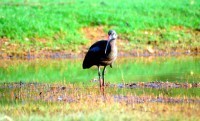
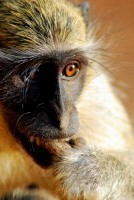
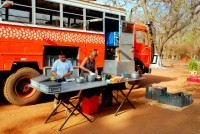
Blog post by Roderick Phillips, author of Weary Heart - a gut-wrenching tale of broken hearts and broken test tubes.
The post Gambia River, Senegal, Day 216 appeared first on Roderick Phillips.
February 28, 2014
Parc National du Niokolo-Koba, Senegal, Day 215
Our destination for today is a bit of a tongue-twister, Parc National du Niokolo-Koba, which hopefully offers more opportunities for wildlife viewing. Having said that if you really wanted to go on safari few people would choose West Africa over East Africa. West Africa has, sadly, hunted its wildlife population to critical levels, so that even in the national parks the wildlife is scarce. Before we go into Parc National du Niokolo-Koba, however, Christi and Hu-man have another cooking assignment coming up and we need to go shopping. We therefore stop at the pleasant-sounding town of Tambacounda, and while Christi, Hu-man and I forage for food, the rest of the group explores. Tambacounda market is hot and dusty and the quality of produce is poor. I think the sell-by date on the produce was a week ago and since we won’t even be using it until tomorrow, Christi is concerned the food will spoil futher overnight on the truck. Still she has 20 hungry mouths to feed, so reluctantly Christi and Hu-man buy onions, garlic, potatoes and carrots. They supplement this with tinned tomatoes and rice, the aim being to make a vegetable curry. There’s also mangoes and oranges together with eggs, bread, and ravioli for breakfast.
From Tambacounda we drive southeast to Parc National du Niokolo-Koba, a UNESCO World heritage site. The main critter I’m hoping to photograph is a hippopotamus. Apparently the best place to observe wildlife in this park is at an area called Simenti, which is located in the heart of the park. It’s a tortuous 90-minute drive through the dry savannah to reach the Simenti hotel, which is perched above a bend in the Gambia River. The river and a nearby watering hole offer the best possibilities for wildlife viewing and photography. However, it’s not the proximity to wildlife that makes the Simenti hotelso appealing, but rather the tempting prospect of an upgrade to an air-conditioned room (at least between 7 pm and 1 am), which comes with that most decadent of all Western inventions, a sit-down toilet. The hotel swimming pool is simply icing on the cake. Quick, where do I sign? Who do I give the money to? I think I’m in heaven.
Enjoy a wonderful dip in the pool and then Christi and I amble over to the watering hole, past a number of vervet monkeys and a warthog that call the grounds of the hotel home. Shame there’s not as much wildlife at the watering hole. Wait expectantly for 7 pm and the delightful sound of the air-conditioner springing to life in our room. Now this is heaven.
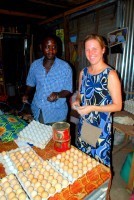
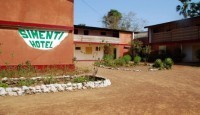
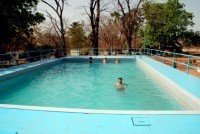
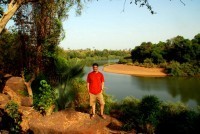
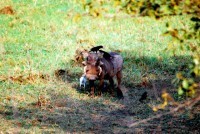
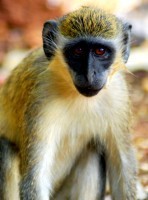
Blog post by Roderick Phillips, author of Weary Heart – a gut-wrenching tale of broken hearts and broken test tubes.
The post Parc National du Niokolo-Koba, Senegal, Day 215 appeared first on Roderick Phillips.
February 27, 2014
Kayes, Mali, Day 214
Breakfast at 7 am after an unpleasant night under the stars. Take a quick group photo by a nearby Baobab tree, pack up the camp and deal with the bags (boy is this becoming tedious) and we’re on the road by 8 am. The temperature climbs rapidly and no one is happy at the prospect of another hot, smelly day on the truck. Adonis quells any insurrection by stopping at the village of Kayes to allow folks to find cold drinks and air-con.
In temperatures that again sit comfortably above 110oF, a cold coca cola is about as close to heaven as it’s possible to get. It is a taste orgasm. And what the hell two orgasms are always better than one so I order a second coke and grasp the ice-cold bottle and savor the numbing feeling for a while before downing its contents. Somewhat refreshed, Christi and I then go on to explore the village, which is virtually deserted. Where is everyone? The answer is down by the banks of the Senegal River doing the weekly wash. A concrete platform extending across the river (and beneath a massive bridge) gives ample space for the locals (men, women, and children) to suds up. Radios are blaring and there’s a party atmosphere. Who knew doing the laundry could be so much fun? The locals either use washboards or simply pound their clothes on the concrete and stones. Not only are clothes being washed, but so are the goats. People are literally scrubbing their goats clean and I don’t know why. Is it for some religious ceremony or are the animals to be sold? Life in rural Mali, well away from the admittedly very limited tourist trail, is a mysterious affair. And Christi nearly missed all this. She gives me a withering look, although stops short of jumping in the river to bathe (or pushing me in).
It’s time to leave Mali – truly the gem of West African tourism – for Senegal. Our border crossing is a Diboli/Kidira. There’s nothing ahead of us but more driving to yet another bush camp. It’s another hot, dusty evening and tempers are becoming a little frayed. Remarkably the food continues to be fantastic; the bad news is that I have two cook groups to complete before the end of the trip in 9 days time. (My first cook group should have been during the time I went to Timbuktu). My least favorite aspect of bush camping is using the bathroom. On a Dragoman trip a shovel is placed a discreet distance from the camp and you take it with you to your own favored spot when Nature calls. After burying your nightsoil, replace the shovel in the appropriate spot so the next person can wander the Sahel in search of inspiration. So now you know. And don’t forget the hand sanitizer!
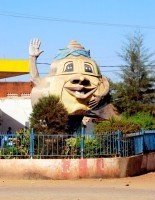
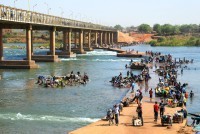
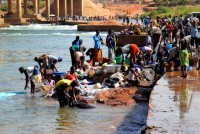
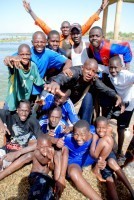
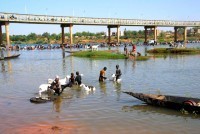

Blog post by Roderick Phillips, author of Weary Heart - a gut-wrenching tale of broken hearts and broken test tubes.
The post Kayes, Mali, Day 214 appeared first on Roderick Phillips.
February 26, 2014
Kati, Mali, Day 213
The engine in the Dragoman truck is revving and about to pull out of the Sleeping Camel when a dusty, dirty Jeep Group arrives from Timbuktu. I learn from Agatha Christie that they had about the same amount of time as Christi and I in the desert metropolis and the cost of the trip ended up being about the same as flying, so Christi and I are feeling rather smug. Christi actually pleads to continue our trip to Dakar by air, having no wish to bush camp. She snorts at the idea that camping in the baking hot bush and with no facilities whatsoever could be considered fun. An hour out of Bamako we come to our one and only stop for the day: the Kati animal market.
For Western sensibilities, the market is rather too authentic. The animals certainly do not have rights and supporters of PETA would probably be having a conniption as brightly colored herders occasionally break away from their conversations to whack their livestock (mostly cows and goats) or throw some seriously chunky rocks at them. There’s no sentiment here as mothers and babies are sold and separated. The Dragoman truck and passengers certainly look out-of-place at the Kati market. It’s hot, dusty, and dirty, yet the herders seem to be enjoying the social aspect of the event as much as the business transactions. While the cattle market dominates the scene there is also a separate goat market, while firewood is also in demand (surely not for heating). Animal transportation to and from the Kati animal market verges on the cruel. The locals think nothing of strapping goats onto the top of a mini-van, while I also watch a cow being tied up and forced into the rear section of a station wagon.
The rest of an unbearably hot day is spent on an increasingly hot truck. At one point, I rest my hands on my trousers and within a minute large sweat patches appear. If we close the flimsy curtains to shade us from the brutal heat we can see nothing of the West African Sahel we came to explore. At lunch John Malkovich places his thermometer in the sun and the temperature reaches 52oC, which is 124oF (and need I remind you that we have no air-conditioning or even a fan). John is not the only one feeling a little frazzled.
We bush camp about 90 minutes to the east of the town of Kayes and not far from the border with Mauritania. Which reminds me, while we were in Bamako Adonis contacted the Dragoman fixer in this unknown African country. The fixer, who goes by the wonderful name of Ahmed the Finger, is another Tuareg. The Tuareg are famed for their guiding skills, and Ahmed the Finger is willing to lead a non-Dragoman trip through Mauritanian Sahara. Several of our group have expressed an interest in continuing to travel through West Africa overland, notably Sheldon Cooper. Time will tell how many step up to the plate.
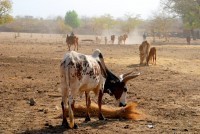
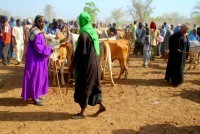
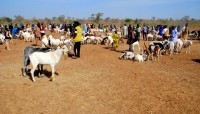
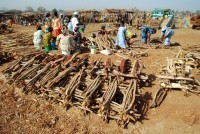
Blog post by Roderick Phillips, author of Weary Heart – a gut-wrenching tale of broken hearts and broken test tubes.
The post Kati, Mali, Day 213 appeared first on Roderick Phillips.
February 25, 2014
Bamako, Mali, Day 212
Christi and I decide to explore downtown Bamako, although even getting there is a nightmare. We cross the wide shallow Niger River via the Bridge of Martyrs. All manner of humanity and pollution-belching vehicles (notably mopeds, motorcycles, cars, and trucks) zoom past at chaotic speeds. It’s amazing there are no accidents, especially for those people stupid enough to walk.
Bamako also has very few street signs, so the map we were given by the good folks at the Sleeping Camel is only as good as the guesses we make. More by luck than judgement we find our way to the Place des Martyrs and then bear north-east along what we think is the Boulevard du People. This street is lined with market stalls, meaning that we have to walk on the road, which remains chock-a-block with traffic. The people of Bamako clearly have places to go and people to see and they don’t appreciate it if you stop for a moment to consult a map. The pace of life is frenetic; people are constantly in our faces, eager to be on their way or eager to stare at us. Either it is disconcerting as Christi and I are relieved to finally reach our intended destination, the fetish market. The market is smaller than I’d expected, just a few stalls selling mostly dried animal parts (notably heads, paws, hoofs, skins and tusks). There are also bits of bird, monkey, snake, dog and warthog to peruse. Supposedly these items are very important for use in a variety of traditional medicines, although we confine ourselves to a few photos.
We continue north past the now defunct Bamako train station to Bamako’s National Museum whose main attraction is beautiful air-conditioning. We enjoy it for as long as possible while nibbling on a lunch of club sandwiches and OJ). There are two main exhibition rooms in the museum. The first houses a temporary display of Malian furniture that Christi adored. The main permanent exhibits are of some fantastic Telem terracotta statues, Dogon masks, and many different examples of Malian textiles. Later that afternoon the Adonis drives the Dragoman truck to the museum and the rest og the group join Christi and I to listen to a free concert given by Lobi Traore (La Bambara Blues Maestro) who plays some very smooth blues music. (note sadly, Lobi Traore died in Bamako some 4 months after our visit) Traffic congestion after the concert is unbelievable. We drive 1 mile in one hour and walk a second mile back to the Sleeping Camel in 20 minutes.
Malian music is famous throughout the world and many clubs in Bamako have live bands, so after dinner some of us seek out some nocturnal entertainment. Apparently the Diplomats Club is the place to go. There is lots of drinking, presumably to lubricate the vocal chords, before the band takes to the stage at midnight. As the music begins, the always energetic Malians take to the dance floor and basically go crazy. We remain content to watch, while alcohol and goodness knows what else keeps the locals partying hard long after we leave.
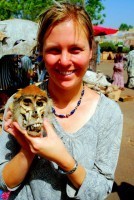
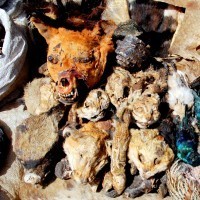
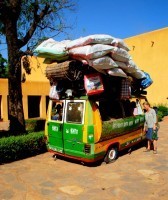
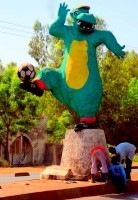
Blog post by Roderick Phillips, author of Weary Heart – a gut-wrenching tale of broken hearts and broken test tubes.
The post Bamako, Mali, Day 212 appeared first on Roderick Phillips.
February 24, 2014
Sahara Desert to Bamako, Day 211
Choosing the cheap accommodation option in Timbuktu (which sits on the edge of the Sahara Desert in case I hadn’t mentioned it) means no air conditioning and not even a fan. So it was hot; real hot last night. We did have a mosquito net and since Timbuktu is also just a few miles from the Niger River it’s possible, I suppose, that an enterprising mosquito might buzz into town looking for an easy meal.
We have very little time to explore this morning, but since the Sahara is right on our doorstep (and at some point during the night slipped under the door of our room) Christi and I wander around a bit. Not too far you understand. We didn’t want to get lost and have to drink outr own urine or blood to survive. In fact as soon as we began to feel a bit thirsty we high-tailed it back to civilization, well Timbuktu, anyway (we’re such wimps). Still the Sahara is at its most attractive in the cool of the early morning, before the heat begins to rise and life becomes a daily struggle just to survive.
We will return to the Sahara several times over the next few months, but for now we’re leaving the desert and returning (eventually) to the cool, refreshing climate along the Atlantic coast. Sadly, our ultimate destination is not the idyllic Brenu beach in Ghana this time, but the cosmopolitan city of Dakar in Senegal. And while the first part of our return journey is by deliciously comfortable air travel, the rest will be bumping along dusty, dirty tracks aboard the Dragoman truck, the highlight of which will be bush camping (I know it will be a highlight because it says so in the brochure).
Ali the Ice collects a rather hot and sweaty Christi and me from our cheap and cheerful hotel before stopping at the posh hotel where Stan and Sinead glide into Ali’s 4WD smelling pine-fresh and sporting a healthy glow from their recent massages. Bastards. Our flight from Timbuktu to Mopti is 45 easy minutes and it’s another 75 minutes to Bamako, the capital of Mali. If all goes well the Jeep Group will reach Timbuktu sometime today. By that point we will have rejoined our Dragoman group. In fact Granpere organizes a transfer for Stan, Sinead, Christi and I to ferry us to the current Dragoman hotel, which is called The Sleeping Camel. Our billet is actually a tent on a small patch of brownish, dying grass. This is more than made up for by a nearby patisserie, which serves the freshest, most delightful orange juice.
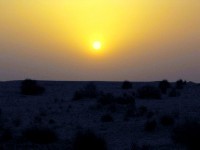
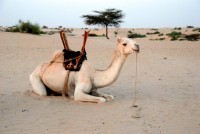
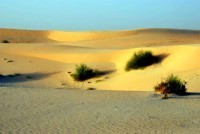






Blog post by Roderick Phillips, author of Weary Heart – a gut-wrenching tale of broken hearts and broken test tubes.
The post Sahara Desert to Bamako, Day 211 appeared first on Roderick Phillips.

